

The economy of the desert community in pioneer days was, and still is for that matter, tied inextricably to the road through Cajon Pass. Practically everyone used this route to travel back and forth between the desert and the inland valleys or the coast. The miners and ranchers, as well as the immigrants and freighters, utilized the pass, and the supplies and services provided to the desert dwellers by those "down below" came through the same corridor. In 1861 John Brown significantly improved a pack trail through Cajon Pass and charged toll for its use.
During the early 1870s the toll road, or "turnpike" as many called it, was kept in poor condition in the opinion of many of the teamsters, desert residents and others who regularly used the road. In the spring of 1875 Captain Lane and his friend, George Blake, determined to take action to correct the problem and ran an advertisement in the March 29th issue of the San Bernardino Weekly Argus:
|
THE UNDERSIGNED gives notice that in consequence of the bad condition of the Cajon Toll Road, that unless the road is put in thorough repair by the 1st. day of May, the citizens living between the Point of Rocks and Lane's Crossing, they will decline to pay toll after the above date. A. G. LANE
|
The deadline lapsed, and true to his word, Lane circumvented the tollhouse gate on several occasions. In the summer of 1875 John J. Driggers, who had leased the road from John Brown, was compelled to sue Lane in San Bernardino District Court in order to get him to cease the activity.
Brown participated in the case of Driggers v Lane on behalf of Driggers, and thus two well-known and respected pioneers became pitted against each other. The case soon developed in complexity, extending far beyond the original issue of maintenance. Before it ended, even Brown's authority to charge toll was brought into question.
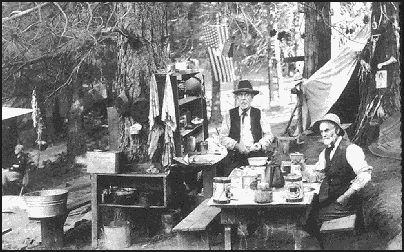

SANFORD'S ROAD THROUGH CAJON PASS
The toll road was an adaptation of the old Spanish Trail, which, prior to Brown's improvement, was suitable only for pack trains, although wagons could be taken through with extreme difficulty. Sydney Waite and Sheldon Stoddard used the road on their trip into California in 1849, and their wagons had to be unloaded and actually dismantled in order to traverse the steep and narrow, boulder-strewn canyons characterizing the east Cajon route.
The following year, freighters Phineas Banning and W. T. B. Sanford constructed a much better wagon road through the west Cajon valley. The route was not nearly as rough as the crossing on the old Spanish Trail five or six miles to the east, but it lengthened the travel by several miles and it was described as being excessively steep at the summit.
In 1855 the west Cajon route was further improved by Sanford, who constructed a new summit crossing about one and one-half miles west of his original road. The grades of this road were stated to be "only 30%," although the last 150 yards were acknowledged to be "precipitous." In the case of one caravan of fifteen wagons, it was reported that the usual unloading and reloading of the freight was avoided only by hitching 32 mules, in turn, to each wagon.
BROWN'S TURNPIKE AND
VAN DUSEN'S ROAD BUILT
So while Sanford's road was definitely an improvement, the trip over the summit was still arduous for those hauling heavily loaded conveyances. The steep grade vexed the freighters for years, and it was not until 1861, with the increased trade to the mines and the need to transport heavy machinery to Holcomb Valley, that the impetus was provided to do something about the situation. The Los Angeles Star ran an article on April 6, 1861, proclaiming that it was essential to improve the road that was so vital to the economy of the Southland:
This road is the great thoroughfare from Los Angeles and San Bernardino to the great gold and silver fields now known to exist and which at present are being worked, east of the Sierra Nevada and Coast Range Mountains. And not only this, but over it all the travel from the north, not passing over the San Fernando Mountain, going southward, must pass. At the head of the cañon is one of the steepest mountains in the State, over which a road passes, and teamsters have always complained of the great difficulties encountered in the ascent. So severely has this been felt, that many of them have offered $5 a load toll to any parties who would cut down the mountain and make a turnpike road of it. As the travel on this road has been greatly increased of late by the trade to the mines, it has become absolutely necessary to take steps to improve the mountain pass road. For this purpose subscription lists have been circulated this week here and in San Bernardino, to raise money to cut down the road across the mountain, and thus facilitate transit to the mines. |
Although it is not clear from this article, there were actually two separate roads under review. One would connect the mines at Holcomb Valley with Cajon Pass by traversing down the north slope of the San Bernardino Mountains, and this was the one to be constructed with funds obtained from subscriptions. The other road was proposed to go through the pass and link the desert to the valley, and was to be built as a private venture for the purpose of collecting toll.
On April 20th, the Star reported that prospective subscribers for the Holcomb Valley road had appointed a committee consisting of prominent Cucamonga citizen John Rains, freighter W. T. B. Sanford and Los Angeles merchant Francis Mellus, who had examined the road and had returned with recommendations for alternative alignments. The cost was less than the $2,000 previously estimated, and it turned out the amount needed had already been collected. Elsewhere in the same issue of the Star, an article stated that Jed Van Dusen, the miner who later built the Holcomb Valley road, had been over the proposed route a second time, and he felt it was much better than he originally had supposed.
Meanwhile, on April 17th the state had passed legislation entitled, "An Act to Authorize the Construction of a Wagon Road in the Cajon Pass," which gave John Brown, Henry M. Willis and George L. Tucker the right to construct a road and to collect toll for its use at rates to be determined each year by the County Board of Supervisors. Work began immediately under a contract granted to Sydney P. Waite, Horace C. Rolfe and David N. Smith, who directed a crew of 30 to 40 workers. The job before them would not be easy, since the route went through some very difficult terrain.
The road began at Martin's Ranch near present-day Devore and traversed Cajon Canyon. Partway up the canyon, at what is now Blue Cut, was the narrowest segment of the lower portion of the road, known at that time as the "lower narrows." Continuing up the canyon along the bank of the creek, the road entered a ravine currently called Crowder Canyon, but known as Coyote Canyon in pioneer times.
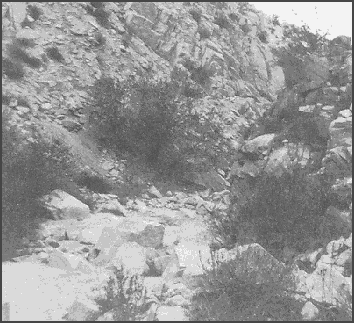
This area, which was referred to as the "upper narrows," is extremely constricted in places, and is strewn with boulders, many of considerable size. The road followed the canyon bottom for a distance before turning up the steep ascent towards the summit. This was the section of road that caused the most trouble, both during the initial construction and subsequently with maintenance. By midsummer the construction was complete, and the Board of Supervisors established what seems to be a fairly stiff toll:
Man &
Horse-------------------------------------.25 |
Shortly after the completion of the turnpike and Van Dusen's road, Mellus hired the freighting firm of Banning and Hinchman to move a boiler weighing 8,000 pounds from Los Angeles to Holcomb Valley. The boiler was to be used at the quartz mill, where they crushed the ore. There were differences of opinion on whether the monstrous apparatus could be hauled over the mountains, but under the direction of the capable Sanford, the feat was accomplished.
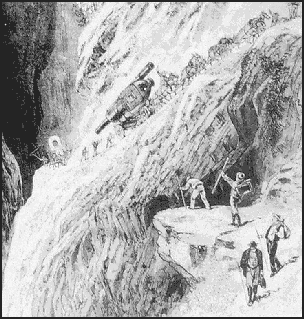
The wagons left Los Angeles on the 17th of July and arrived at Holcomb Valley on August 13th. This had been the first major challenge for Brown and his road, and he had done everything in his power to assist Sanford in his efforts. The Los Angeles Star, reporting on their success, said, "All wagons from Los Angeles and San Bernardino now go by the turnpike -- the old Spanish trail, made into a good wagon road, having grass and water within easy distances."

BROWN FACES HARDSHIPS DUE
TO FLOODS AND MARAUDERS
The toll road was associated with John Brown from the very beginning, the other two men being financial backers. Henry Willis was a lawyer at the time and later a judge, and he became very prominent in the San Bernardino area. George L. Tucker, referred to as "the Major," was a successful investor.
In July of 1861 Tucker received the attention of the press when he bought the American Exchange, a saloon located across from the well-known Bella Union Hotel in Los Angeles. "Major Tucker," said the Star, "has been in enterprises in this section heretofore, having been one of the joint purchasers of San Bernardino rancho in 1857, when the Mormons sold out and left that place."
Willis and Tucker lent Brown $213.50 each, a total of $427, to build the road. This must have been in addition to the money they put up for their own shares. The funds were lent at three-percent interest per month, a common figure for the time, and were to be paid back out of the proceeds from the toll collection. Brown was in a position to buy out Willis' interest in the road before the end of 1861, and was able to buy Tucker's share by April of 1863.
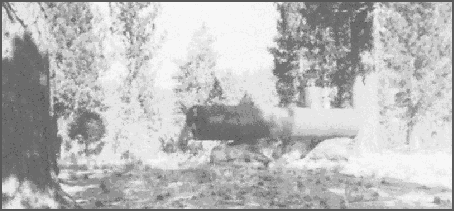
In February 1862 the Board released Brown from paying taxes on the toll road, for reasons not entirely clear from the minutes, but presumably having to do with the damage done to the road by the terrible storms that inundated San Bernardino County in the winter of 1861/62. There was some question whether Brown would be able to restore the road at all, due to financial concerns.
The rains had begun in late December of 1861, and by early January much of the area had already experienced heavy flooding. On January 10th, a Holcomb Valley man by the name of J. G. Nichols hiked out of the mountains by way of the desert road, and according to his reports the Mojave River was running very high, and he could see lakes all over the desert where none had been before. In describing the pass, he said, "...there is no road at all, the torrents have swept every thing out of their way."
John Brown, though devastated by the loss of his road, resolved to rebuild it, and as can be seen in this January 12th correspondence to Judge Benjamin Hayes, Brown's biggest obstacle was funding for the project:
It has been raining three weeks steadily at San Bernardino. My road...is all washed away; all my former work is lost; I have now to make a new road, or lose all that I have expended. Some people advise me to quit road-building, but I am determined to build a road at all hazards. I returned from the road yesterday, and shall go back to-morrow with the men, etc., to build it up again. My greatest trouble is the money to pay. Is Godey or Miguel Ortiz in Los Angeles? |
Brown did restore the road, but it took most of his assets. He was forced to sell all of his hay and the larger portion of his cattle.
John Brown might not have been so determined to rebuild his road if he had known of the headaches that were in store for him. One of his problems, at least for the original tollhouse, was marauders. He had built the structure in the upper narrows, and its vulnerable location below a bluff made it an inviting target.
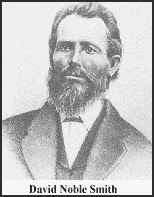
In May of 1862 Indians attacked and wounded the keeper of the tollgate, David Noble Smith. According to an account given by W. F. Holcomb, the attack occurred around sundown, when Smith and a hired man named Larkin Reeder were working outside in the yard in front of the tollhouse (John Brown had left the area to take his family to the safety of the city, because he had seen several signs of Indians in the Cajon area). The Indians slipped up into some cover on the steep bluff overlooking the station and began firing on the two men, which sent both of them running for the tollhouse. Before reaching safety, Smith was seriously, though not mortally, wounded.
A few days later Holcomb passed through the area on his way to the mountains and learned of the attack. He enlisted the aid of three others and tracked the band of Indians up Lytle Creek, over the mountains and out into the desert, eventually giving up the chase at Tehachapi.
Another incident, which made the news, occurred a year later in May of 1863, when the tollhouse was visited by horse thieves. Some "light-fingered gents" entered Brown's pasture at the station and stole two of his fine mules and a saddle horse, plus two additional horses belonging to a man freighting goods to Holcomb Valley. They sent for the sheriff, who tracked the thieves for some distance into the desert, but was unable to catch up with them. The newspaper warned, "If there are any more of the same breed of dogs left behind, expecting to make a similar haul, I would advise them not to be seen lurking in the vicinity of the tollgate," and offered a bet that "Don Juan gets the scalp of the first suspicious individual he catches about his premises."

A SECOND TOLLHOUSE BECOMES NECESSARY
John Brown's daughter, Louisa, who married San Bernardino attorney Byron Waters, recalled some of the events that took place in Cajon Pass in a story she wrote for a magazine article many decades later. She said her father's principal duties were to collect tolls, keep the road in good repair, and keep an eye out for hostile Indians.
Early on it was discovered that some cattlemen were avoiding the toll by skirting the tollhouse in the upper narrows. This was simple enough to do by merely going through the west Cajon valley over Sanford's road, which connected to Brown's turnpike below the tollhouse. Louisa wrote that the solution to the problem was the construction of another tollhouse at the lower narrows.
Based on statements in the judge's instructions to the jury in Driggers v Lane, the lower tollhouse was put in place three or four years after the road was built. Thanks to a July 1864 trip to the Arizona mines by celebrated chemist and metallurgist Benjamin Silliman, Jr., the date can be even further pinpointed. Silliman wrote a report of his journey, in which he mentioned the new tollgate:
An adventurous pioneer on the outskirts of civilization has erected a toll gate just before entering the Cajon Pass, where he exacts a fee of all passers in return for some labor bestowed upon the road at that point; this 'black mail' is cheerfully paid to the self-constituted supervisor. |
Louisa does not mention the names of the cattlemen who avoided the toll, but the revenue lost from Lane's few livestock, or that of any other single Mojave dweller at that time, was not enough to warrant constructing and manning a new station. The one exception might have been the Parrish ranch in Summit Valley, but it is more likely that the source was the herds of "foreign" stock, such as those brought by J. E. Pleasants and others from the Los Angeles area.
Pleasants, in fact, admits that on his trip in 1864, the drovers took the wagons "through the toll gates, but took the stock up the canyon, not having to go through the gate." Brown's loss in this one incident was $150 (five cents times 3,000 head of cattle), which makes Pleasants' cattle drive the prime candidate for the reason the tollhouse was constructed at the lower narrows -- and the dates jibe.
MORE PROBLEMS WITH INDIANS AND FLOODS
The keepers of the lower tollhouse fared much better with the Indians than those at the upper station. Louisa Waters wrote that her father had taken precautions against the Indians by building high board fences around both tollhouses, and that at the lower station he had dug a cave into an embankment to be used as refuge during an attack. Actually, it was more likely that the cave was used for storing supplies, as stated in an anonymous article appearing in a Covered Wagon Days program. The precautions at the lower tollhouse proved unnecessary, as the only difficulty with Indians there was when eight of their best horses were stolen.
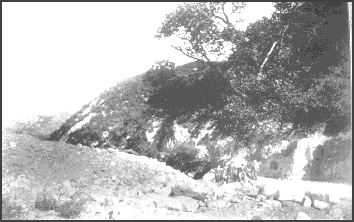
SITE OF BROWN'S ORIGINAL TOLLGATE IN THE LOWER NARROWS. THE CAVE HE DUG INTO THE BANK, MOST OF WHICH STILL EXISTS, APPEARS AT BOTTOM RIGHT OF PHOTO. |
The upper tollhouse was not as fortunate. There were further incidents involving Indians in and around the upper narrows, one of which was recounted by pioneer George Miller. Miller tells the story of the time Sydney P. Waite noticed a bluejay darting down on something concealed in the bushes on the bluff. Always on the alert for Indians, Waite was suspicious and fired a shot into the area where the bird was flitting about. Nothing moved, nor was there any sound, but after thinking about it overnight, he investigated the spot the next day and found the dead body of an Indian.
In December of 1867 another round of major storms began, and soon after the first of the new year, reports came in that the road had been greatly damaged and that the floods had "torn it all to pieces." It was virtually impassable, but Brown gave assurances that he would repair it as soon as the weather permitted. In a letter to the editor of the San Bernardino Guardian dated January 22nd, Brown wrote that he was making steady, if not rapid, progress on the restoration of his road:
I am way up here above the clouds, amidst the snow-capped peaks of the Sierra Nevada, trying to repair the damage done to the Cajon road during the floods; I feel confident for the task, and am making good headway. Only two places remain bad and they are not so as to prevent teams from passing through the Cañon. A government train, heavily loaded, passed on the way to Camp Cady safe on Friday last. I would have made better progress in repairing my road, had not some villain broke my iron scrapers to pieces, carrying off my chains and injuring the tools I have to work with. |
In a report to the Board of Supervisors, Brown gave a financial statement for the year ending December 31, 1867. He showed total expenses on the road equaled $8,203.45, while total receipts were only $6,261.68, for a net loss of $1,941.77. The report was included in the minutes of the November 19, 1867, meeting, so his figures had been projected to the end of the year. His costs, therefore, could not have included his losses from the heavy damages caused by the floods, and thus appear to be quite high for ordinary annual expenses.
In spite of Brown's declared losses, the Board ordered the toll rate to remain as originally established. This decision did not seem to be in accordance with the legislative act, which stipulated that the Supervisors "shall not so establish, or reduce, the rates of toll, so as to make the dividend on said road less than three per cent. per month upon a fair valuation of the said road...." A complete accounting is not given in the Board's minutes, so the reasons behind the decision to leave the toll unchanged are not fully known.
One area where Brown did receive some assistance was in a reduced appraisal, and therefore, a reduced tax. The toll road originally had been assessed at $1,000, but in 1867 the figure had declined to $800, and by 1869, the assessment was only $600. However, though the declining appraisals were a temporary financial advantage, they actually represented a reduction in the value of the road, which meant that Brown's investment was being undermined by the constant flooding problems.
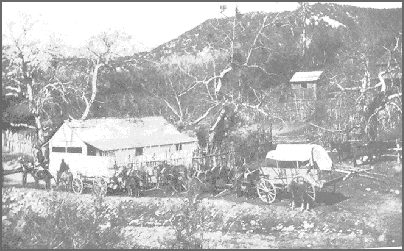
LEASES ROAD TO MCKENNEY AND MATHEWS
In April of 1868 Brown ran an advertisement announcing he had leased the road out to others for a period of one year so that he could take a vacation:
The undersigned...would respectfully inform his friends and the public that he has leased his Toll Road in the Cajon Pass, to the enterprising gentlemen, McKenney & Mathews, for the term of one year, they taking possession on the 25th Inst., and are to keep the road in good repair.... This road is twelve miles in length, crossing the entire range of the Sierra Nevada, and like all other mountain Roads is subject to damage by floods. The proprietor has spared no pains in keeping the Road in repair at all Seasons of the year. No Road in the State is kept in better condition.... |
Brown did not reveal in his announcement whether the burdens of tending to his hellish road had anything to do with his decision, but he did make what seem to be somewhat defensive comments about the job he had been doing in maintaining the road. Brown often sounded defensive about the turnpike, so there must have been more than just a few complaints, however it was not until the mid-1870s that the condition of the toll road became a major issue.
Flooding problems revisited the pass in March 1869, when torrents of rain from a cloudburst did extensive damage to Brown's toll road. The road was impassable for heavily loaded wagons, and a large work crew was needed to restore it.
The road crossed Cajon Creek about one-half mile above the lower narrows on what was then the site of the Faurot house (later called Bear Flat Ranch or Station, and now known as Cosy Dell). During the storm, three men attempted to cross the creek at this spot, but the flooding was so bad they lost their wagon and everything in it, their four horses drowned, and the men only narrowly escaped with their own lives.
The destruction once again of his road must have made Brown feel the job he had taken on was next to impossible. But some of the travelers on the turnpike were unsympathetic to the problems he faced in maintaining it, and as the traffic on the road grew over the years, so did the protests about the condition in which it was kept.
Historical accounts show that the trip over the toll road was difficult, to say the least. In 1865 Elliot Coues had traveled through Cajon Pass on a journey in which he retraced the route taken by Francisco Garces in 1775-76, and the data Coues gathered on the trip was later published in his book, On the Trail of a Spanish Pioneer. He described Brown's turnpike as a "narrow, deep and tortuous canyon, the roughest I have ever traversed on wheels; there was ten miles of this from the tollgate to Martin's ranch."
Others were just as dissatisfied as Coues. In 1873, after receiving increasing complaints and a petition from teamsters objecting to the sorry state of the road, the Board of Supervisors agreed there was a need to address the problem, although no action was taken at that time.

A DIARIST'S JOURNEY THROUGH CAJON PASS
On the other side of the issue, there were some who felt that travel through the pass was much improved because of Brown's turnpike and that he should be commended. One of the few descriptions favorable to travel on the toll road was given by an anonymous author in the journal of a trip he took to Ivanpah. The San Bernardino Guardian published the account in a series of four articles beginning on September 9, 1871.
The journey began on August 8th, when the author, traveling on law business and accompanied by a deputy sheriff, left San Bernardino at nine o'clock in the morning in a somewhat heavy and "by no means handsome" buggy drawn by two mules. They took with them a "nice little outfit of knick knacks in the way of oysters, sardines, crackers, etc.," and did not forget to take along a "demijohn of fine old rye, said to be good for snake bite." After traveling a distance of twelve miles, they stopped to water their animals and refresh themselves at the Cajon Pass station operated by Englishman George Martin.
Martin's Ranch was situated east of what is now Glen Helen Ranch near Devore, and was established at least by 1858. The 1862 Assessor's Record Book shows that Martin was living on public land, and had assets consisting primarily of his house, 32 head of cattle and 12 horses. Over the years he added extensively to the original 160 acres of government land. The 1870 census lists him as owning real estate worth $10,000, and the appraisers of his estate estimated his holdings in Cajon Pass at an impressive 2,700 acres.
Because of the station's strategic location at the mouth of Cajon Canyon, most of the travelers using the pass stopped there, thus it was often referred to in military reports, diary entries, and the newspapers. George ran his "public house" -- the English equivalent for "way station" -- with his wife, Sarah. Living in the home in 1870 were seven of their eight children (the eldest, Charlotte, had married John Prothero). Martin’s Ranch prospered until George's death in 1874, and like Lane's Crossing, it had become associated in the public mind with its owner, and continued to be called by its original name for many years even though the proprietor was no longer there.
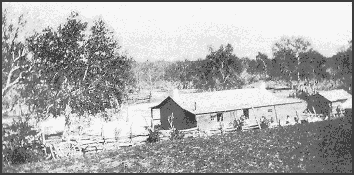
The two travelers kept their stay at Martin's brief, about 20 minutes, and then "drove up to the toll gate and through the cañon to a station known as the Upper Toll Gate," arriving there at three o'clock in the afternoon. This way station was run by James Fears, a Tennessee emigrant who moved to Cajon Pass sometime during the 1860s.
He and his wife, Naomi, both 51 years old in 1870, lived in the pass with two of their daughters, aged 14 and 23. Another daughter, Rebecca Ann Bennette, and her two children moved to a separate house in the pass during the late 1860s, following the death of her first husband. One of her children, John, was still living in the Oro Grande area some 40 years later. "Uncle Jim," as Fears was often called by those who knew him, finally left Cajon Pass in 1874 and moved to Spadra, and he remained in that vicinity until his death in 1892.
Fears was well thought of by the people in this area. The editor of the Guardian once stated, "We know Mr. F to be a clever, honest man, one who makes no promises he is not able to fill." Uncle Jim naturally became acquainted with Captain Lane, and the two were on good terms, which is evidenced by their partnership in the Monarch claim in the Ord Mountain Mining District.
The anonymous diarist and the deputy were treated well during their overnight stay at the station. Immediately upon their arrival, Uncle Jim fed and watered their animals. He then took the men in to meet the other travelers, a group apparently comprised of some teamsters who were hauling two wagonloads of goods to Hardyville on the Colorado River, and a soldier who had been discharged recently from the guardhouse at a military post after being tried and cleared for the killing of two Indians.
That evening Mrs. Fears set the dinner table with delicious food and venison steaks "cooked to a nicety as only Mrs. F knows how." After dinner the diarist and his companion took a run up into the hills while there was still daylight, and returned to indulge in a smoke before turning in for the night. At five o'clock the next morning the two men were awakened by Uncle Jim's call for all hands to come to breakfast, and as soon as they finished eating they hitched up the mules and resumed their journey.
The author concluded his narrative on this segment of the trip by entering into his journal a commendation of John Brown's accomplishments on the turnpike:
Our fellow townsman Mr. John Brown is deserving of the thanks of this community, of the teamsters, and last but not least the poor devils (the mules) who have to pass over this road, for the work that he commenced, finished and still keeps in good order; this route through and over the Cajon Pass. To the many who travel this road it is accepted as a matter of course, but to an old and observing traveller it is really a work reflecting credit on the designer and constructor. |
The diarist's and others good opinion of Brown's turnpike was outweighed by those who brought significant commerce into San Bernardino, and by 1874 improvement of the road had become a primary issue. The freighting traffic on the turnpike had escalated greatly, due primarily to the demand for supplies at the new mining town of Panamint and the huge shipments of provisions being sent to the older mining communities in Arizona and the eastern Mojave Desert.
An excellent example of the magnitude of the supply system was given in an article in the Guardian, which described a single wagon train made up of 30 wagons with twelve-mule teams and carrying some 200,000 pounds of freight bound for Hardyville and Prescott, Arizona. For anyone who has visited the upper narrows and has seen the boulder-strewn route through the winding canyon, it is hard to visualize how anyone could have maneuvered such heavy loads and huge teams of animals through there.

BROWN MAKES IMPROVEMENTS TO TOLL ROAD
In the latter part of 1874, John Brown finally decided to make some improvements to the turnpike, a decision no doubt spurred for the most part by the explosion of activity created by the Panamint mines, and the constant flow of traffic between there and the Southern Pacific railhead at Spadra. The increase in toll collections from this traffic was substantial enough to support a major reconstruction on the steepest segment of the road near the summit.
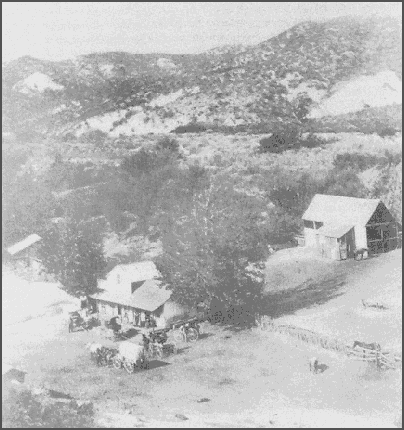
In September Brown promised to relocate the road, so that teams could "go through the low gap to the right of the top of the hill, thereby avoiding the high ascent of the present road." He also planned to improve the new route by blasting a 185-foot segment in order to reduce the grade even further. In early December it was reported that a "splendid highway" was under construction, and Brown announced he would "spare no expense in improving it to perfection." On December 28th the San Bernardino Weekly Argus gave a glowing account of the project:
THE NEW ROAD -- The new road being built by Mr. Brown is certainly a great improvement. It intercepts the toll road about a mile above Fear's station and runs in a direct line for Panamint and is nearer Bear and Holcomb valleys, and other mining districts, than the old road. Mr. Brown has had considerable experience in road building and has selected an excellent grade over the summit, perfectly straight, and wide enough for teams to pass each other nearly all the way. The summit is a hard cement formation and has to be blasted. Several cuts are being made and hollows filled, some a long distance. The work was finished in early February, and Brown, in an ebullient mood, said, "I wish...to inform the traveling public that the so-much-talked-of new wagon road through the Cajon Pass, is finished, the last spike driven." |
LEASES ROAD TO DRIGGERS
Brown was finally on the verge of success with this most difficult endeavor. He had every prospect for enormous profits from the Panamint trade, yet he apparently decided he had had enough of its never-ending maintenance problems and he leased the road to John J. Driggers of San Bernardino.
The lease, which began on May 1, 1875, was for a period of one year at $125 per month, and included all the houses and barns at the lower tollgate. Driggers was to maintain the turnpike in such condition that "ten and twelve mule teams and wagons" could safely "and conveniently pass along and over said road." Brown reserved the right for his family, and the families of his sons-in-law, Sydney P. Waite, Byron Waters and W. R. Wozencraft, to use the road free of charge, not to exceed two freight wagons and one stage.
Though Brown's turnpike had undergone a total reconstruction at the summit, repair elsewhere on the road had been neglected. There were people who were still dissatisfied, Captain Lane among them. It was in the month following completion of the project that he and George Blake published their notice that they and the other Mojave River settlers would "decline" to pay toll after May 1st if the road was not repaired.

DRIGGERS V LANE
Within three weeks after the deadline passed, Lane began making good his proclamation, and Driggers, now in control of the turnpike, was forced to file suit against him. The attorneys representing Driggers were Rolfe, Waters and John Brown, Jr. Lane used the law firm of Paris, Bledsoe and Goodcell. The complaint listed six declarations, which are noted here in brief:
1) The State Legislature passed an act authorizing the construction of the road and the collection of toll for a 20-year period. 2) The road was surveyed and constructed as required, commencing at Martin's Station and ending at a point two and one-half miles northeast of Fears' Station. 3) Willis and Tucker sold their interests in the road to Brown. 4) Brown leased the road to Driggers. 5) On May 19 and May 21, 1875, defendant A. G. Lane "forcibly passed through the toll-gate thereon with one two-horse wagon without paying and refusing to pay the legal toll"; and again on June 12th, June 15th and July 21st, he "turned out of said road with his said two horse team, and passed around said gate on ground adjacent thereto, and again entered said road and continued traveling on the same without paying and refusing to pay the legal toll...." 6) "That defendant is indebted to said plaintiff for said legal toll in the sum of $6 and according to law, for turning out of said road three times to avoid paying the legal toll $5; for each offense, $15, and for forcibly passing through said gate three times without paying the legal toll, $25 for each offense, $75, amounting in all to $96." |
Lane's response to the suit took an interesting turn when he or his lawyers decided to challenge Brown's right to operate the lower tollgate at the southern end of the turnpike, where travel over the public road had been blocked. Obstruction of the public highway was expressly forbidden in Section 3 of the legislative act for the toll road, which stated, "Said road...shall not hinder nor obstruct the existing traveled road through said pass."
This was recognized even during construction, as the June 1, 1861, issue of the Los Angeles Star stated:
This road does not in the least infringe upon, impede or obstruct the travel on the present road through the Pass, but the grant locates the turnpike through the canyon that was traveled by the large immigration that came into this valley in 1847, which pass for some eight or ten years has been almost entirely abandoned, except occasionally its being used as a pack trail. |
In his answer to the complaint, Lane alleged that Brown could not legally collect toll at all on the lower portion of the turnpike, since for the most part that stretch of road had not been a new construction, but merely an improvement of the existing public road. "...Plaintiff is not now and has not been in charge of any toll road upon which he was authorized to collect toll," Lane asserted. Further, "...Said road is not and never has been a toll road, but the same is a Public highway free for all persons to travel over and has been so for twenty years last past."
His final allegation stated, "...Plaintiff has Erected and is Keeping a toll gate upon a public highway that has been in use for twenty years...and was used as a Public highway ten years before the passage of the act of Legislature...."
The public highway utilized Sanford's road in the west Cajon valley and then followed an alignment of the old Spanish Trail. Lane was not challenging Brown's right to charge toll for the section of his road in the east Cajon that crossed over the summit and ran down through Crowder Canyon. He was contesting that portion southerly of the present-day truck scales operated by the California Highway Patrol on Interstate 15, which was where Brown's turnpike and the public road both came together and followed the alignment of the Spanish Trail. This section was open to the public until Brown built the lower tollhouse at a point where the narrows were just a few yards in width.
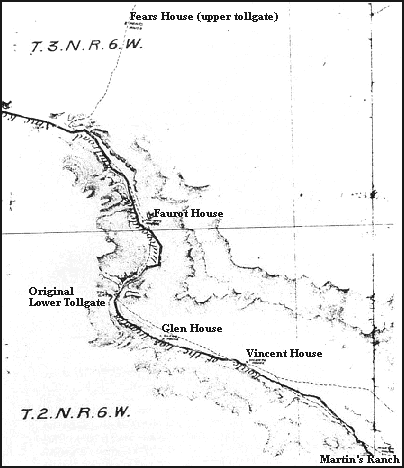
SECTION OF 1875 LOS ANGELES AND INDEPENDENCE RAILWAY MAP, FROM MARTIN'S RANCH TO FEARS' HOUSE. FAUROT'S HOUSE IS LATER CALLED BEAR FLAT RANCH, TO WHERE THE LOWER TOLLGATE WAS EVENTUALLY MOVED. THE FORK AT THE NORTH END OF THE MAP IS WHERE THE TOLL ROAD JOINS WITH THE ROAD FROM SANFORD'S PASS. THE SITE NAMES ARE TOO SMALL TO READ, SO THEY HAVE BEEN TYPED IN. |
The group of witnesses called upon to testify was an impressive assemblage of early pioneers who might have been expected to know every aspect of the history of the road, or of travel in Cajon Pass for that matter. Included were David Noble Smith and Sydney P. Waite, both of whom helped build the road and at one time served as tollkeepers on the turnpike. Also giving testimony were David Seely, Parley Heap, Chris Taylor, J. B. Forbes, Archibald Martin, a Mr. Prothero (probably John), and a half-dozen others. Surveyor Fred T. Perris and his chainman, J. E. Pick, also were called upon to testify.
Altogether fifteen witnesses were paid for appearing in court, most of them for three days. Fred Perris was paid an additional $50 for "diagnosis," which most likely meant he served as the equivalent of today's "expert witness."
The statements of the witnesses were not transcribed, but the judge's instructions to the jury were recorded, and show that the focus of the case centered on construction that was done 13 years previously in the vicinity of the lower tollhouse. The road in this area was extensively damaged in the 1862 storms, and Brown graded a new one on higher ground for about one-half mile parallel to the original road. This became the crux of Lane's defense, since Brown's tollhouse, fences and structures blocked the original track from public use.
The judge's instructions are summarized here, as they assist in understanding the direction of the case:
1) The toll road could not be constructed in such a manner as to hinder travel to such a degree as to cause the public road to fall into disuse. If the jury found from the evidence that the public road had been so obstructed by Brown, then plaintiff could not recover his losses. 2) If any portion of the public road was taken over by the plaintiff, and toll demanded from the defendant for passing over that section, then that toll was unlawful and the jury should not find for the plaintiff. 3) This point introduces the issue of Brown's blockage of the old road that was damaged in the 1862 storms. The instructions reveal that the public was allowed free access to his newly-graded road until the lower tollhouse was constructed. The judge stated that if the jury found that at this time Brown had erected a fence, or corral and barn, or other obstruction across the narrows for the purpose of preventing the public from using the old track, then the plaintiff was to lose the suit. 4) If the jury found that Brown had built any obstruction for the purpose of causing the one-half mile of old road to be abandoned by travelers so that it would fall into disuse, then the verdict should be for the defendant. 5) If the road was simply straightened and improved at the narrows so as to cause the public to travel upon these improvements for three or four years prior to erecting the toll gate, then plaintiff could not win the suit. 6) If the old road had been abandoned and had fallen into disuse before the erection of the fence, then the building of the fence did not affect the right to collect toll, and the jury could find for the plaintiff. |
From the instructions it can be seen that the issues are complex, but essentially the jury is being asked to decide whether Brown had intentionally caused a section of the old road to fall into disuse, or whether it had been abandoned simply because a better road was available. If the latter were the case, then toll could be collected legally, in that the old road had become public because of usage over the years, and if several years passed without the road being traveled, the public lost that right.
The case was argued before the court on the evening of October 3, 1875, and after a short deliberation, the jury found for the plaintiff. The press received information that this was not the end of the issue, for on October 5th it was reported, "There will probably be more of the case.... We learn that another suit will be brought and that the case recently decided will be appealed to the Supreme Court." The decision was never appealed nor were there any other lawsuits, but the issue of excessive tolls and poor maintenance did not subside until the turnpike became a public road and the fees were discontinued.

Captain Lane was not ready to give up yet in his fight for a public highway. During the trial the judge had directed that if any individuals wanted a toll adjustment when utilizing the public road, they must apply to the Supervisors. The Board alone, he stated, had the right to regulate toll on the road.
Lane subsequently circulated a petition, which was signed by D. Cahill, William Pierce, John Prothero, and others living on the river, requesting that they be allowed to reopen the old road at the earliest opportunity. The petition was submitted to the Board and discussed during the meeting of December 7, 1875. It read, in part:
Your petitioners living on the Mojave River being heavily taxed in consequence of the high rates of toll charged on the Toll Road running through the Cajon Pass in the County, and the old Road formerly running through the said Pass having been hindered and totally obstructed by the owner of the said Toll Road, which is itself almost impassable, respectfully ask that they be allowed the privilege of opening the old road through the said Cajon Pass. |
The Board granted the petition without further comment, thereby setting up a potential confrontation, though no reports of subsequent conflicts can be found.
The Board's grant of the petition came to naught, and complaints about the toll road resumed. In October of 1876 the newspaper published an editorial on the issue, being very careful not to accuse the respected proprietor of the turnpike of being remiss:
We have heard many complaints from persons living on the Mojave on account of the expense they are under in traveling to and from town by having to pay high rates of toll and many of the settlers are even talking of transfering their trade from this town to Mojave Station [Kern County railroad station]. No complaints are made of the road or its proprietor, who is under very heavy expenses in keeping the same in repair, and to whom they give the credit of doing his duty faithfully, but they think that, as the county is benefitted by their trade it should furnish them a road at public expense and relieve them of the onerous tax to which they are now subjected. A burden which is crushing to the few becomes light when supported by the many. If a fair figure were offered, the proprietor would undoubtedly dispose of his franchise and the road could be opened to the public. It may be well for our Supervisors to give this matter their serious consideration as we are not strong enough to bear the loss of the business of so important a tract as the Mohave. |
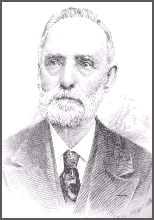
Months passed with no action being taken, until finally the Supervisors ordered John Brown to appear before them and explain why the toll should not be reduced. Following a delay due to illness, Brown did appear before the Board on March 11, 1878, to plead his case. He successfully argued to keep the old toll rates, but the Board ordered one modification in the toll collection: he was to allow teams and wagons hauling forage to the summit to pay only one way, provided they returned empty.
Brown also was ordered to construct two turnarounds in the upper narrows, and to improve the road at a place called Point of Rocks, also located in the upper narrows (not to be confused with Point of Rocks on the Mojave River). He was given a deadline of June 1, 1878, to complete the improvements.
One week before the deadline, on May 24, 1878, Brown sold the toll road franchise to Jesse Tay and Charles M. Lawrence, both of whom were miners prior to coming to San Bernardino in 1875. Having learned from his experience with the Driggers case and perhaps fearing further action by the Board of Supervisors, Brown inserted a clause in the transfer documents to protect himself from future grief:
The grantor in no way guarantees the right to collect tolls on said road nor the validity of the said franchise nor its duration nor the legality of such tolls, but the grantees assume all risk as to those matters, and to take this transfer subject to such risk and no claim or adjudication in any way impairing or annulling the right to collect on diminished tolls on said road shall ever in any manner create any liability against grantor.... |
On the same day as the sale, Tay and Lawrence took out a mortgage that included the Bear Flat Ranch property and all of its improvements. They then moved the lower tollgate to the ranch, and headquartered all their operations there.
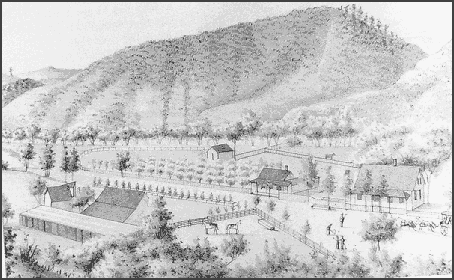
October 17, 1882, was a day for the Mojave settlers to celebrate. That was the day the charter for the turnpike finally expired, and the road became a public thoroughfare. One of the newspapers reported, "Some ingenious person has draped the toll gate pole in black and swung it over the road so travelers may mourn over the event of its demise, but at the top of the pole is a sprig of evergreen, emblematic, we suppose, that no more toll has to be paid." It is easy to imagine Aaron as one of those who had a hand in the ceremonial last rites for the tollgate, but the responsible parties remain anonymous.

 PAGE
1|
2|
3|
4|
5|
6|
7|
8|
9|
10|
11|
12
PAGE
1|
2|
3|
4|
5|
6|
7|
8|
9|
10|
11|
12

